Complete Solutions to physics of chapter ELECTROSTATICS of Class 12 book with complete answers and questions
| Class 12 | PHYSICS |
| Chapter | ELECTROSTATICS |
| DISHA | physics |
| Number Of Questions | 100 |
| Academic Year | 2023-24 |
Three charges Q, `+q` and `+q` are placed at the vertices of a right-angled isosceles triangle as shown. The net electrostatic energy of the configuration is zero if Q is equal to
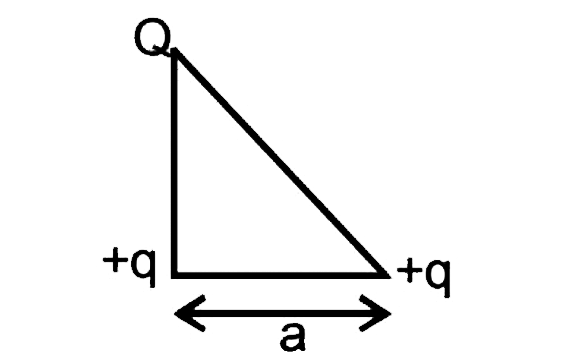 04:53View Solution
04:53View SolutionIf `3` charges are placed at the vertices of equilateral triangle of charge 'q' each. What is the net potential energy, if the side of equilateral `Delta` is `l cm` ?
01:45View SolutionIf identical charges `(-q)` are placed at each corner of a cube of side `b`, then electric potential energy of charge `(+q)` which is palced at centre of the cube will be
03:06View SolutionTwo charges `q_(1)` and `q_(2)` are placed `30 cm` apart, as shown in the figure. A third charge `q_(3)` is moved along the arc of a circle of radius `40 cm` from `C` to `D`. The change in the potential energy o fthe system is `(q_(3))/(4pi epsilon_(0))k`., where `k` is
 03:36View Solution
03:36View SolutionThree particles, each having a charge of `10 mu C` are placed at the coners of an equilateral triangle of side `10 cm`. The electrostatic potential energy of the system is (Given `(1)/(4pi epsilon_(0)) = 9 xx 10^(9)N-m^(2)//C^(2))`
02:06View SolutionTwo equal charges `q` are placed at a distance of `2a` and a third charge `-2a` is placed at the midpoint. The potential energy of the system is
02:23View SolutionAn electric dipole has the magnitude of its charge as `q` and its dipole moment is `p`. It is placed in a uniform electric field `E`. If its dipole moment is along the direction of the field, the force on it and its potential energy are respectively
02:28View SolutionWhen one electron is taken towards the other electron, then the electric potential energy of the system
01:04View SolutionTwo identical charges are placed at the two corners of an equilateral triangle. The potential energy of the system is U. The work done in bringing an identical charge from infinity to the third vertex is
03:26View SolutionPotential energy of two equal negative point charges 2mC held 1 m apart in air is
01:29View SolutionFour charges + q, –q, + q and –q are put together on four corners of a square as shown in figure. The work done by external agent in slowly assembling this configuration is
 02:49View Solution
02:49View SolutionAs shown in figure a dust particle with mass m = 5.0 × 10–9 kg and charge q0 = 2.0 nC starts from rest at point a and moves in a straight line to point b . What is its speed v at point b?
 04:15View Solution
04:15View SolutionCharges`-q , Q, and -q` are placed at an equal distance on a straight liner. If the total potential energy of the system of three charges is zero, then find the ratio `Q//q`.
 .02:36View Solution
.02:36View SolutionWhen the separation between two charges is increased, the electric potential energy of the charges
03:00View SolutionIf a positive charge is shifted from a low - potential region to a high- potential region, the electric potential energy
01:13View SolutionIf V and u are electric potential and energy density, respectively, at a distance r from a positive point charge, then which of the following graph is correct ?
03:21View Solution7S is a solid neutral conducting sphere. A point charge q of 1 × 10–6 C is placed at point A. C is the centre of sphere and AB is a tangent. BC = 3m and AB = 4m.
(1) The electric potential of the conductor is 1.8 kV
(2) The electric potential of the conductor is 2.25 kV
(3) The electric potential at B due to induced charges on the sphere is – 0.45 kV
(4) The electric potential at B due to induced charges on the sphere is 0.45 kV
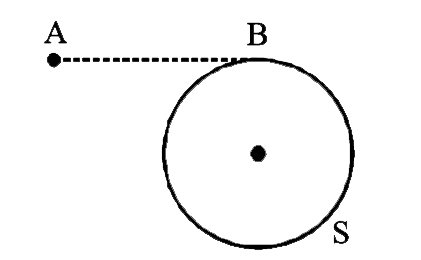 04:33View Solution
04:33View SolutionA proton moves a distance d in a uniform electric field E ®as shown in the figure. Then which of the following statements are correct ?
(1) Electric field do a negative work on the proton
(2) Electric potential energy of the proton increases
(3) Electric field do a positive work on the proton
(4) Electric potential energy of the proton decreases
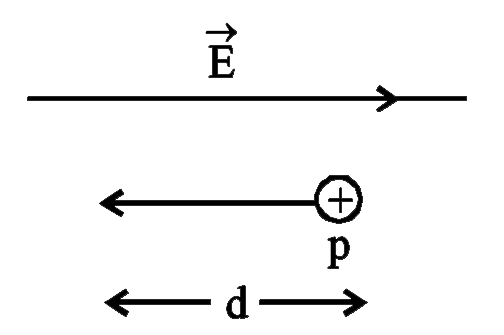 01:41View Solution
01:41View SolutionThree concentric spherical conductors A, B and C of radii R, 2R and 4R respectively. A and C is shorted and B is uniformly charged
Charge on conductor A is
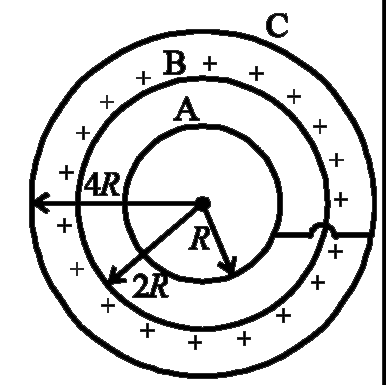 01:53View Solution
01:53View SolutionThree concentric spherical conductors A, B and C of radii R, 2R and 4R respectively. A and C is shorted and B is uniformly charged
Potential at A is
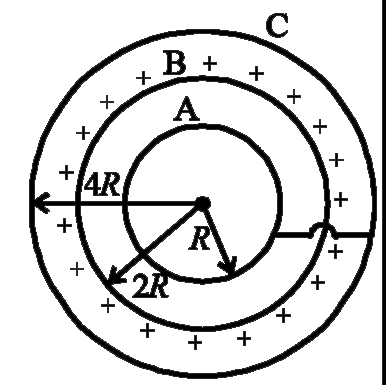 01:46View Solution
01:46View SolutionThree concentric spherical conductors A, B and C of radii R, 2R and 4R respectively. A and C is shorted and B is uniformly charged .
Potential at B is
 02:53View Solution
02:53View SolutionStatement-1 : No work is done in taking a small positive charge from one point to other inside a positively charged metallic sphere while outside the sphere work is done in taking the charge towards the sphere. Neglect induction due to small charge.
Statement-2 : Inside the sphere electric potential is same at each point, but outside it is different for different points.02:00View SolutionStatement-1 : Electric potential of earth is taken to be zero as a reference.
Statement-2 : The electric field produced by earth in surrounding space is zero.01:38View Solution4Statement - 1 : The electric potential and the electric field intensity at the centre of a square having four fixed point charges at their vertices as shown in figure are zero.
Statement - 2 : If electric potential at a point is zero then the magnitude of electric field at that point must be zero.
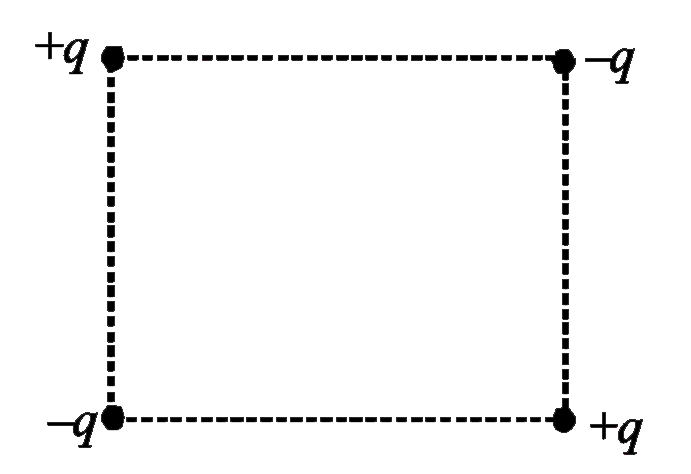 02:07View Solution
02:07View SolutionA parallel plate capacitor is charged to a potential difference of 50V. It is discharged through a resistance. After 1 second, the potential difference between plates becomes 40V. Then
02:41View SolutionFive identical capacitor paltes, each of area A, are arranged such that adjacent plates are at a distance d apart, the plates are connected to a source of emf V as shown in the figure

The charge on plate 1 is ………..and on plate 4 is.............02:49View SolutionThe figure shows two identical parallel plate capacitors connected to a battery with the switch S closed. The switch is now opened and the free space between the plates of the capacitors is filled with a dielectric of dielectric constant(or relative permittivity) 3. Find the ratio of the total electrostatic energy stored in both capacitors before and after the introduction of the dielectric.
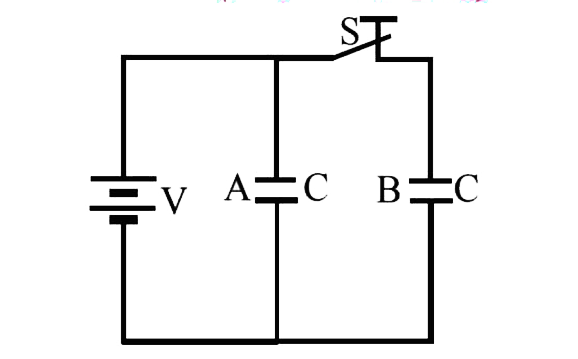 05:01View Solution
05:01View SolutionAll six capacitors shown are identical. Each can withstand maximum `200` volts between its terminals. The maximum voltage that can be safely applied between `A` and `B` is
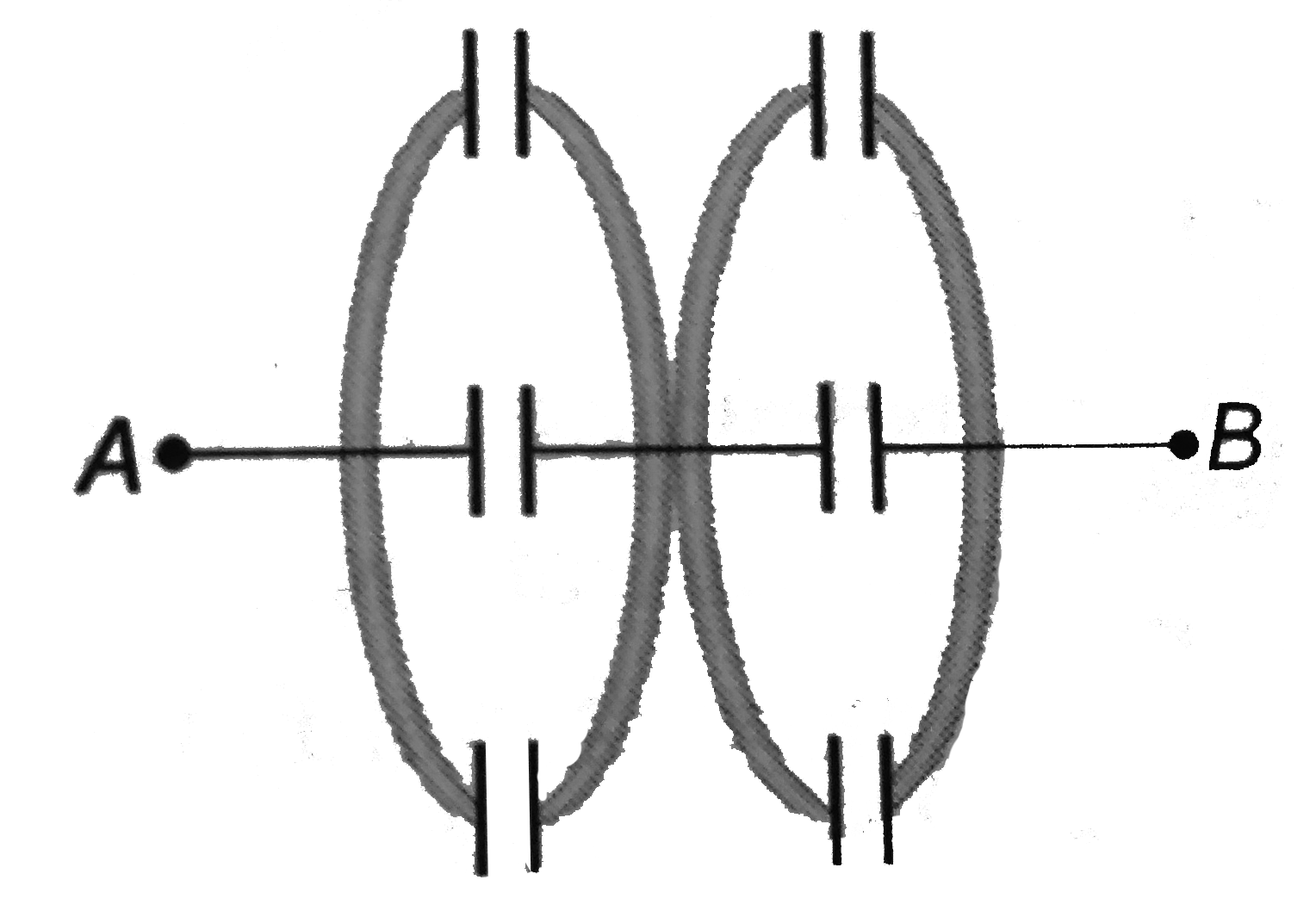 01:37View Solution
01:37View SolutionA capacity of capacity `C_(1)` is charged up to `V` volt and then connected to an uncharged capacitor of capacity `C_(2)`. Then final potential difference across each will be
01:39View SolutionTwo capacitors of capacitances `3 muF` and `6 muF` are charged to a potential of `12 V` each. They are now connected to each other, with the positive plate of each joined to the negative plate of the other. The potential difference across each will be
03:19View SolutionIn the figure a capacitor is filled with dielectrics `K_(1)`,` K_(2)` and `K_(3)`. The resultant capacitance is
 03:02View Solution
03:02View SolutionThe resultant capacitance of given circuit is
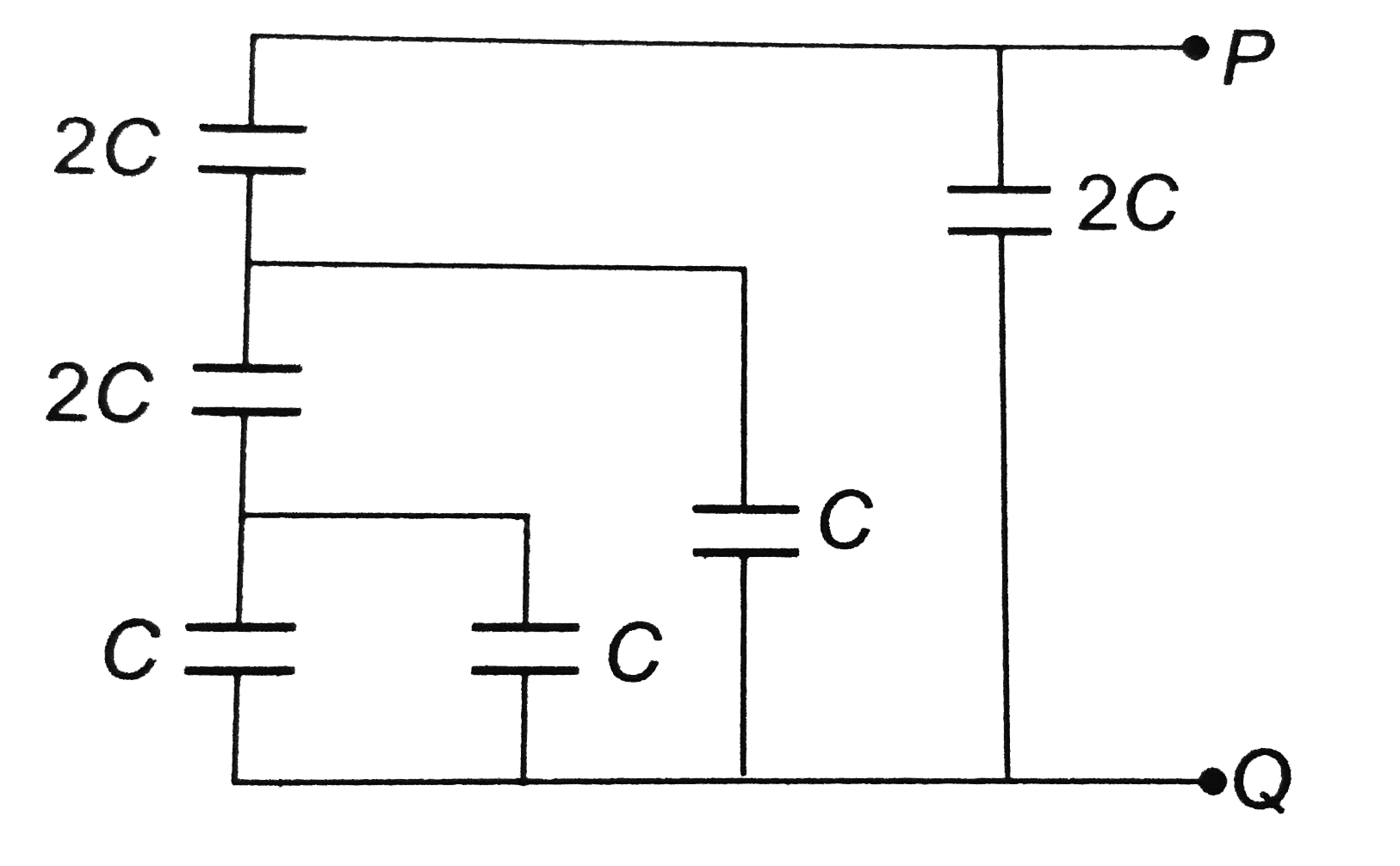 01:58View Solution
01:58View SolutionTwo dielectric slabs of constant K1 and K2 have been filled in between the plates of a capacitor as shown below. What will be the capacitance of the capacitor
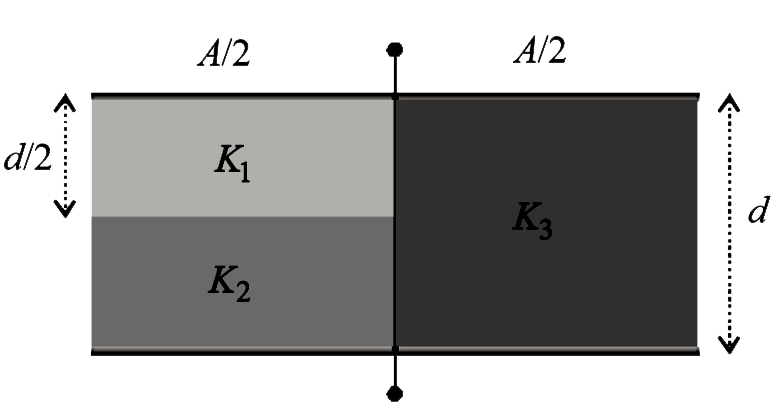 01:12View Solution
01:12View SolutionEight drops of mercury of equal radii possessing equal charges combine to from a big drop. Then the capacitance of bigger drop compared to each individual small drop is
03:13View SolutionSeparation between the plates of a parallel plate capacitor is `d` and the area of each plates is `A`. When a slab of material of dielectric constant `k` and thickness `t(t lt d)` is introduced between the plates. Its capacitance becomes
03:30View SolutionThere is an air filled 1pF parallel plate capacitor. When the plate separation is doubled and the space is filled with wax, the capacitance increases to 2pF. The dielectric constant of wax is
01:09View SolutionBetween the plates of a parallel plate condenser, a plate of thickness `t_(1)` and dielectric constant `k_(1)` is placed. In the rest of the space, there is another plate of thickness `t_(2)` and dielectric constant `k_(2)`. The potential difference across the condenser will be
03:18View SolutionA parallel plate capacitor is charged and the charging battery is then disconnected. If the plates of the capacitor are moved farther apart by means of insulating handles:
03:16View SolutionA parallel plate capacitor of plate area A and plates separation distance d is charged by applying a potential `V_(0)` between the plates. The dielectric constant of the medium between the plates is K. What is the uniform electric field E between the plates of the capacitor ?
01:42View SolutionA parallel plate air capacitor is connected to a battery. The quantities charge, voltage, electric field and energy associated with this capacitor are given by `Q_0` , `V_0`, `E_0` and `U_0` respectively. A dielectric slab is now introduced to fill the space between the plates with battery still in connection. The corresponding quantities now given by Q, V, E and U are related to the previous one as
04:38View SolutionThe false statement are, on increasing the distance between the plates of a parallel plate condenser,
(1) The electric field intensity between the plates will decrease
(2) The electric field intensity between the plates will increase
(3) The P. D. between the plates will decrease
(4)The electric field intensity between the plates will remain unchanged02:39View SolutionThe capacitance of a parallel plate condenser depends on
(1) Area of the plates
(2) Medium between the plates
(3) Distance between the plates
(4) Metal of the plates01:25View SolutionCapacitor `C_(3)` in the circuit is variable capacitor (its capacitance can be varied). Graph is plotted between potential difference `V_(1)` (across capacitor `C_(1)`) versus `C_(3)`.
Electric potential `V_(1)` approaches on asymptote of 10 volts as `C_(3) to infty`
The ratio of the capacitance `C_(1)/C_(2)` will be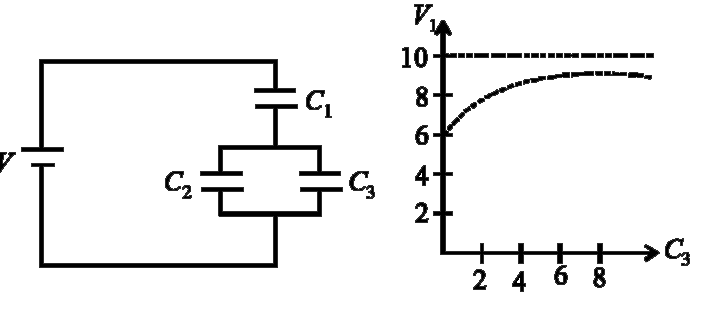 04:53View Solution
04:53View SolutionCapacitor `C_(3)` in the circuit is variable capacitor (its capacitance can be varied). Graph is plotted between potential difference `V_(1)` (across capacitor `C_(1)`) versus `C_(3)`.
Electric potential `V_(1)` approaches on asymptote of 10 volts as `C_(3) to infty`
0The value of C3 for which potential difference across `C_(1)` will become 8V, is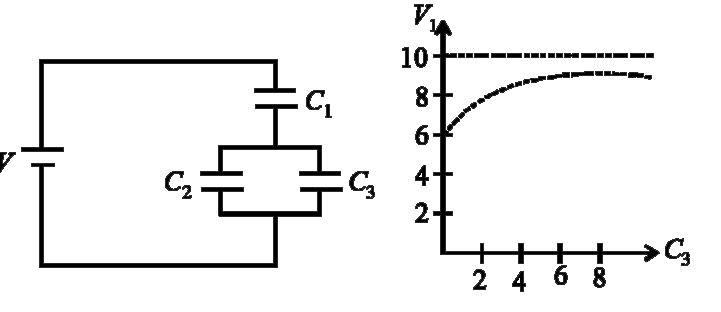 03:15View Solution
03:15View SolutionCapacitor `C_(3)` in the circuit is variable capacitor (its capacitance can be varied). Graph is plotted between potential difference `V_(1)` (across capacitor `C_(1)`) versus `C_(3)`.
Electric potential `V_(1)` approaches on asymptote of 10 volts as `C_(3) to infty`
The ratio of energy stored in capacitor`C_(1)` to that of total energy when`C_(3) toinfty` is 02:27View Solution
02:27View SolutionAssertion: The force with which one plate of a parallel plate capacitor is attracted towards the other plate is equal to square of surface density per `epsilon` per unit area.
Reason: The electric field due to one charged plate of the capacitor at the location of the other is equal to surface density per `epsilon`.02:34View SolutionAssertion: Circuit containing capacitors should be handled cautiously even when there is no current.
Reason: The capacitors are very delicate and so quickly break down.02:30View SolutionAssertion: If the distance between parallel plates of a capacitor is halved and dielectric constant is made three times, then the capacitor becomes `6` times.
Reason: Capacity of the capacitor does not depend upon the nature of the meterial.02:41View SolutionIn the electric field of a point chargde `q`, a cetrain charge is carried from point `A` to `B, C, D` and `E`. Then the ork done
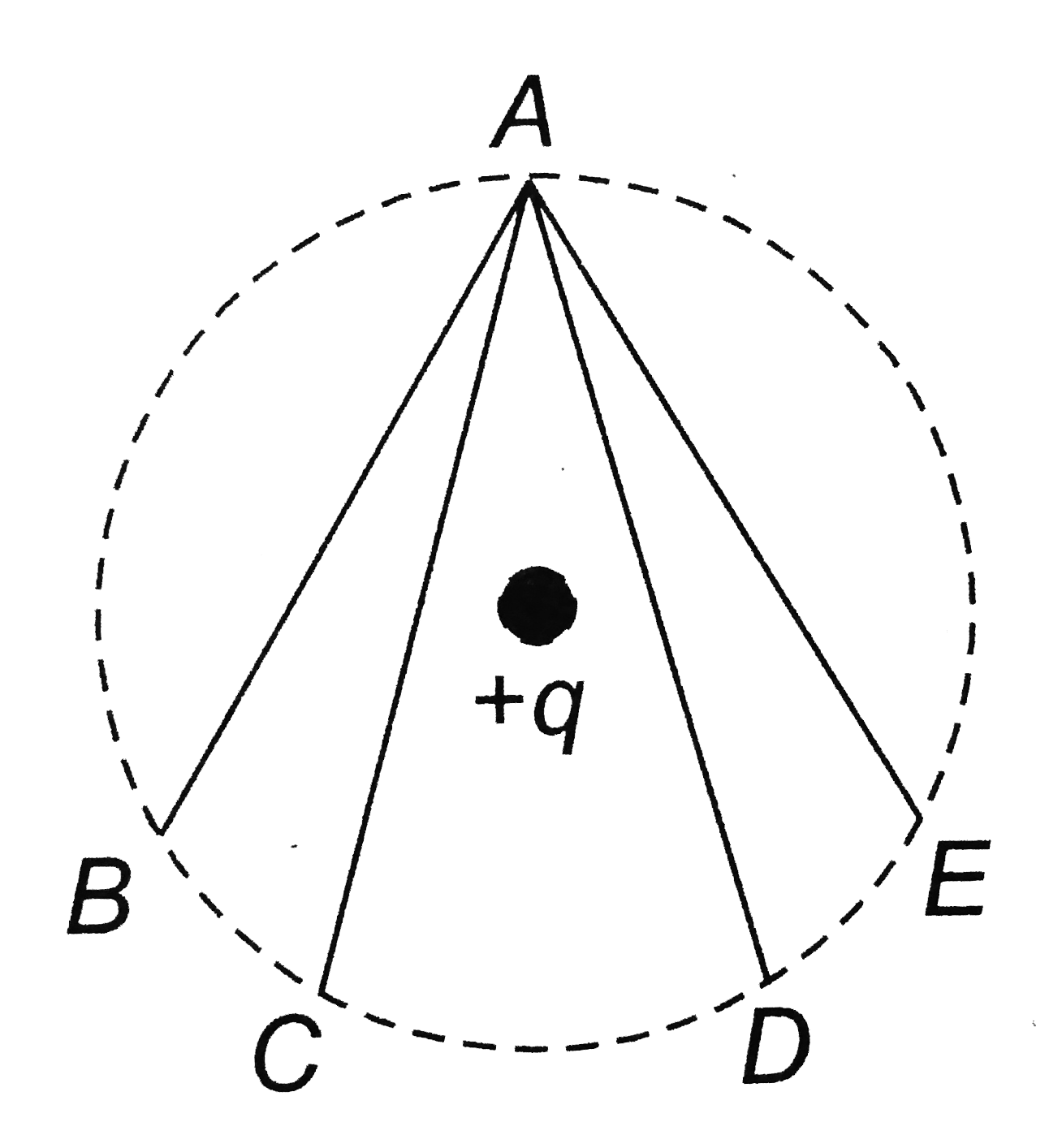 02:09View Solution
02:09View SolutionFour equal charges `Q` are placed at the four corners of a square of each side is 'a'. Work done in removing a charge `-Q` from its centre to infinity is
03:49View SolutionA particle `A` has chrage `+q` and a particle `B` has charge `+4q` with each of them having the same mass `m`. When allowed to fall from rest through the same electric potential difference, the ratio of their speed `(v_(A))/(v_(B))` will become
02:09View SolutionIn the firgure the charge `Q` is at the centre of the circle. Work done is maximum when another charge is taken from point `P` to
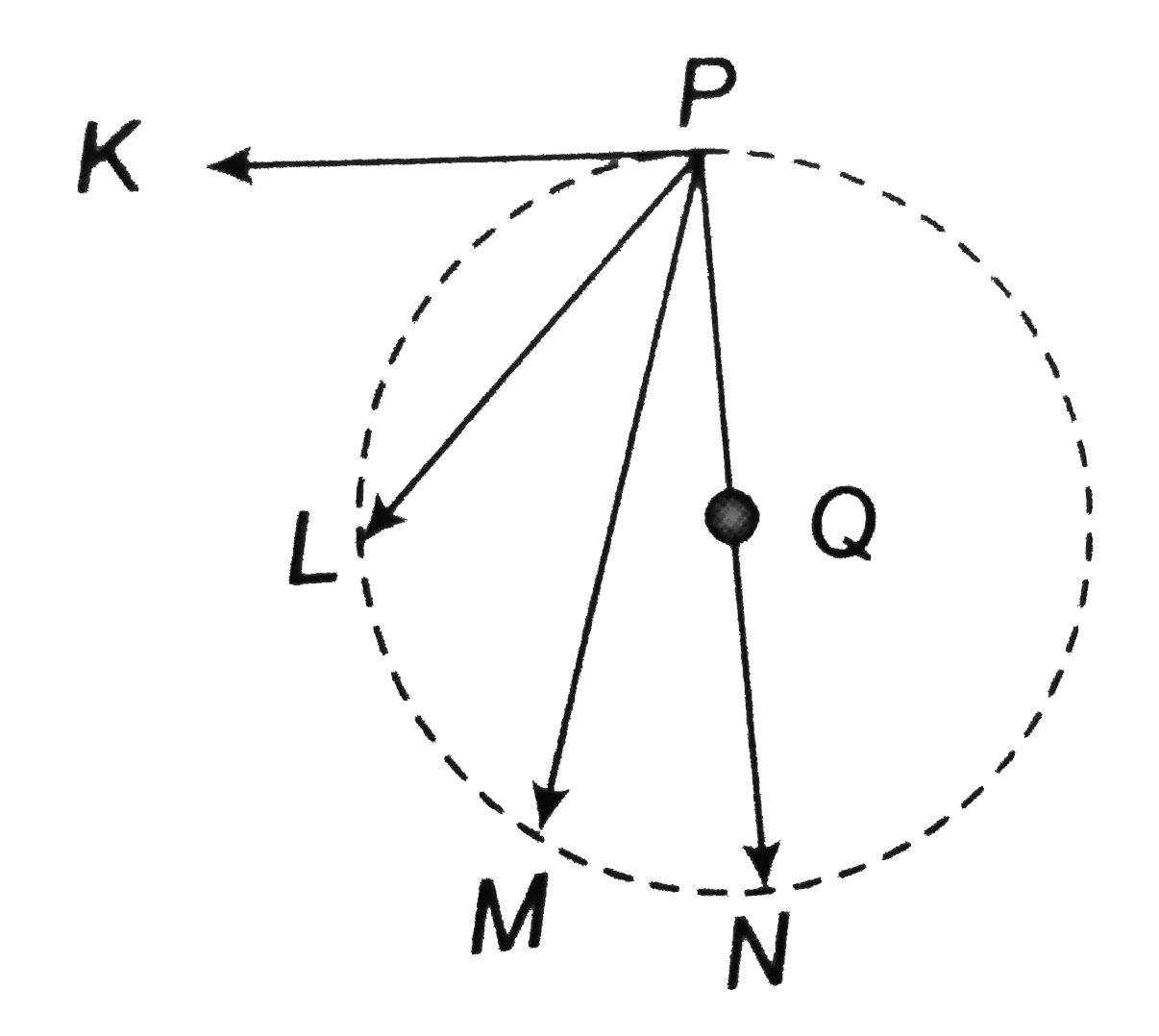 02:07View Solution
02:07View SolutionHow much kinetic energy will be gained by an `alpha-`particle in going from a point at `70 V` to another point at `50 V`
01:39View SolutionTen electrons are qually spaced and fixed around a circle of radius `R`. Relative to `V = 0` at infinity, the electrostatic potential `V` and the electric field `E` at the centre `C` are
01:53View SolutionThe displacement of a charge Q in the electric field `vec(E) = e_(1)hat(i) + e_(2)hat(j) + e_(3) hat(k)` is `vec(r) = a hat(i) + b hat(j)`. The work done is
01:48View SolutionAs shown in the figure, charges `+q and -q` are placed at the vertices `B` and `C` of an isoscles triangle. The potential at the vertex `A` is
 01:25View Solution
01:25View SolutionTwo electric charges `12 mu C` and `-6 mu C` are placed `20 cm` apart in air. There will be a point `P` on the line joining these charges and outside the region between them, at which the electric potential is zero. The distance of `P` from `6 mu C` chrage is
02:01View SolutionIn the rectangle, shown below, the two corners have charges `q_(1) = - 5mu C` and `q_(2) = + 2.0 mu C`. The work done in moving a charge `+3.0 mu C` from `B to A` is (take `1//4 4pi epsilon_(0) = 10^(10) N-m^(2)//C^(2))`
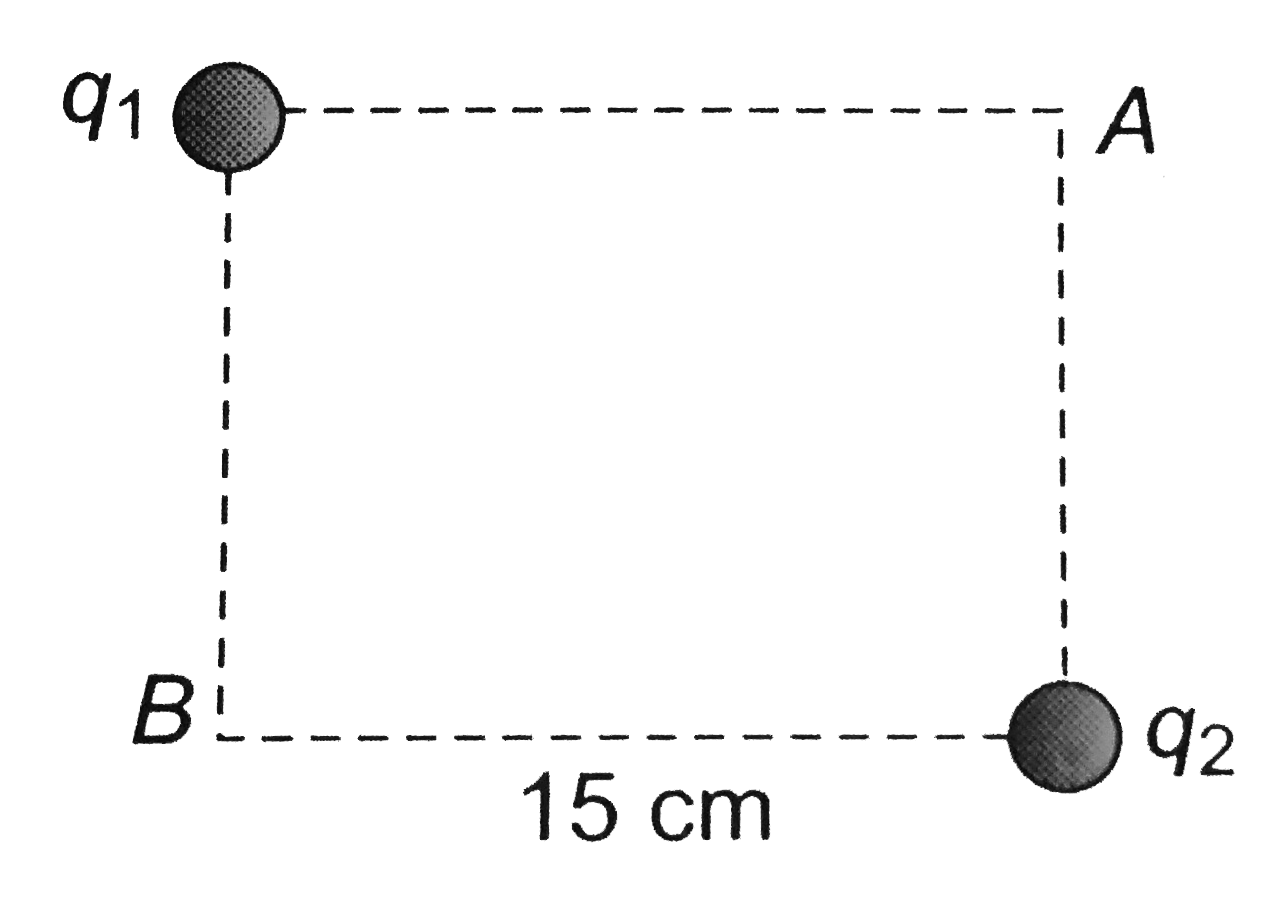 04:48View Solution
04:48View SolutionElectric charges `q, q, –2q` are placed at the corners of an equilateral triangle ABC of side l. The magnitude of electric dipole moment of the system is
01:48View SolutionA charge `(-q)` and another charge `(Q)` are kept at two points `A and B` respectively. Keeping the charge `(+Q)` fixed at `B`, the charge `(-q)` at `A` is moved to another point `C` such that `ABC` forms an equilateral triangle of side `l`. The net work done in moving teh charge `(-q)` is
02:39View SolutionIn an hydrogen atom, the electron revolves around the nucles in an orbit of radius `0.53 xx 10^(-10) m`. Then the electrical potential produced by the nucleus at the position of the electron is
02:06View SolutionPoint charge `q_(1) = 2 mu C` and `q_(2) = - 1mu C` are kept at points `x = 0` and `x = 6` respectively. Electrical potential will be zero at points
03:28View SolutionThe distance between `H^(+)` and `CI^(-)` ions in `HCI` molecule is `1.28 Å`. What will be the potential due to this dipole at a distance of `12 Å` on the axis of dipole ?
02:06View SolutionTwo identical thin ring, each of radius R meters, are coaxially placed a distance R metres apart. If `Q_1` coulomb, and `Q_2` coulomb, are repectively the charges uniformly spread on the two rings, the work done in moving a charge q from the centre of one ring to that of the other is
05:28View SolutionA charge `+q` is fixed at each of the points `x=x_0`, `x=3x_0`, `x=5x_0`,…………`x=oo` on the x axis, and a charge `-q` is fixed at each of the points `x=2x_0`, `x=4x_0`, `x=6x_0`, …………`x=oo`. Here `x_0` is a positive constant. Take the electric potential at a point due to a charge Q at a distance r from it to be `Q//(4piepsilon_0r)`.Then, the potential at the origin due to the above system of
03:47View SolutionA uniform electric field pointing in positive x-direction exists in a region. Let A be the origin, B be the point on the x-axis at `x=+1cm ` and C be the point on the y-axis at `y=+1`cm. then the potetial at the points A,B and C satisfy
a. `V_AltV_B`, b. `V_AgtV_B` c. `V_AltV_C` d. `V_AgtV_C`01:38View SolutionA point `Q` lies on the perpendicular bisector of an electrical dipole of dipole moment `p`, If the distance of `Q` from the dipole is `r` (much larger than the size of the dipole), then electric field at `Q` is proportional to
02:06View SolutionConsider a system of three charges `(q)/(3),(q)/(3) and -(2q)/(3)` placed ar point A,B and C respectively, as shown in the figure. Take O to be the centre of the circle of radius R and angle `CAB = 60^(@)`. Choose the incorrect options
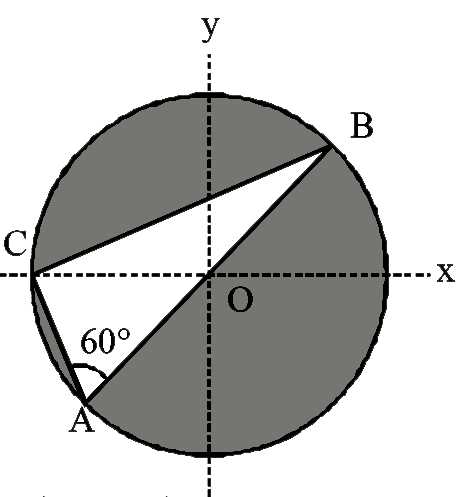
(1) The electric field at point O is `(q)/(8 pi epsilon_(0)R^(2))` directed along the negative x-axis
(2) The potential energy of the system is zero
(3) The potential at point O is `(q)/(12 pi epsilon_(0) R)`
(4) The magnitude of the force between the charges at C and B is `(q^(2))/(54 pi epsilon_(0) R^(2))`05:27View SolutionFor spherical symmetrical charge distribution, variation of electric potential with distance from centre is given in diagram Given that : `V=(q)/(4pi epsilon_(0)R_(0))` for `r le R_(0) and V=(q)/(4 piepsilon_(0)r)` for `r ge R_(0)`
Then which option (s) are correct :
(1) Total charge within `2R_(0)` is q
(2) Total electrosstatic energy for `r le R_(0)` is non-zero
(3) At `r = R_(0)` electric field is discontinuous
(4) There will be no charge anywhere except at `r lt R_(0)`
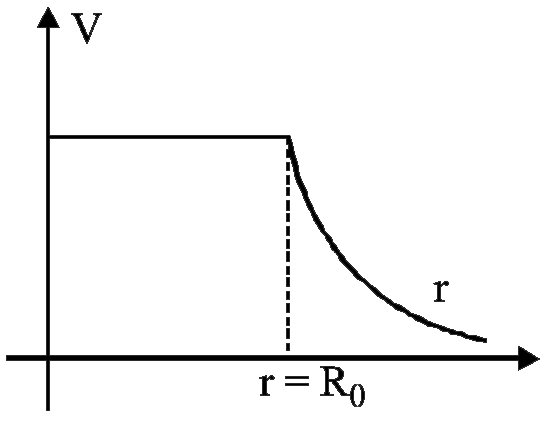 07:21View Solution
07:21View SolutionAn electric dipole (AB) consisting of two particles of equal and opposite charge and same mass is released in an electric field. In the figure field lines are without considering effect of field of dipole.

The centre of mass of the dipole01:51View SolutionAn electric dipole (AB) consisting of two particles of equal and opposite charge and same mass is released in an electric field. In the figure field lines are without considering effect of field of dipole.
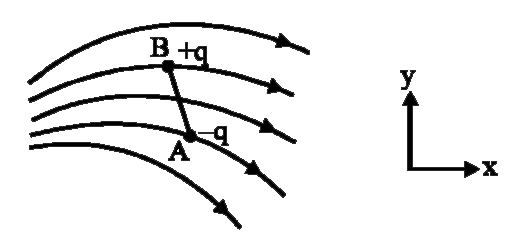
Angular acceleration of the dipole, immediately after it is released01:39View SolutionStatement -1 : A bird perches on a high power line and nothing happens to the bird. Statement -2 : The level of bird is very high from the ground.
01:30View SolutionStatement -1 : Electrons move away from a low potential to high potential region. Statement- 2 : Because electrons have negative charge
01:27View SolutionAssertion: Surface of asymmetrical conductor can be treated as equipotential surface.
Reason: Charges can easily flow in a conductor.01:58View SolutionA total charge `Q` is broken in two parts `Q_(1)` and `Q_(2)` and they are placed at a distance R from each other. The maximum force of repulsion between them will occur, when
05:02View SolutionTwo small balls having equal positive charge `Q`(coulomb) on each are suspended by two insulated string of equal length `L` meter, from a hook fixed to a stand. The whole gravity (state of weightlessness). Then the angle between the string and tension in the string is `
 03:18View Solution
03:18View SolutionElectric charges of `1mu C, -1 mu C` and `2mu C` are placed in air at the corners `A,B` and `C` respectively of an equilateral triangle `ABC` having length of each side `10 cm`. The resultant force on the charge at `C` is
04:02View SolutionAn electron is moving round the nucleus of a hydrogen atom in a circular orbit of radius `r`. The coulomb force `vec(F)` between the two is (where `k=(1)/(4piepsilon_(0)))`
01:32View SolutionEqual charges `q` are placed at the four corners `A,B,C,D`of a square of length `a`. The magnitude of the force on the charge at `B` will be
05:30View SolutionThe charges on two spheres are `+7muC` and `–5muC` respectively. They experience a force F. If each of them is given an additional charge of `–2muC`, the new force of attraction will be
01:43View SolutionElectric lines of force about negative point charge are
01:34View SolutionFigure shows the electric lines of force emerging from a charged body. If the electric field at`A` and `B` are `E_(A)` and `E_(B)` respectively and if the displacement between `A` and `B` is `r` then
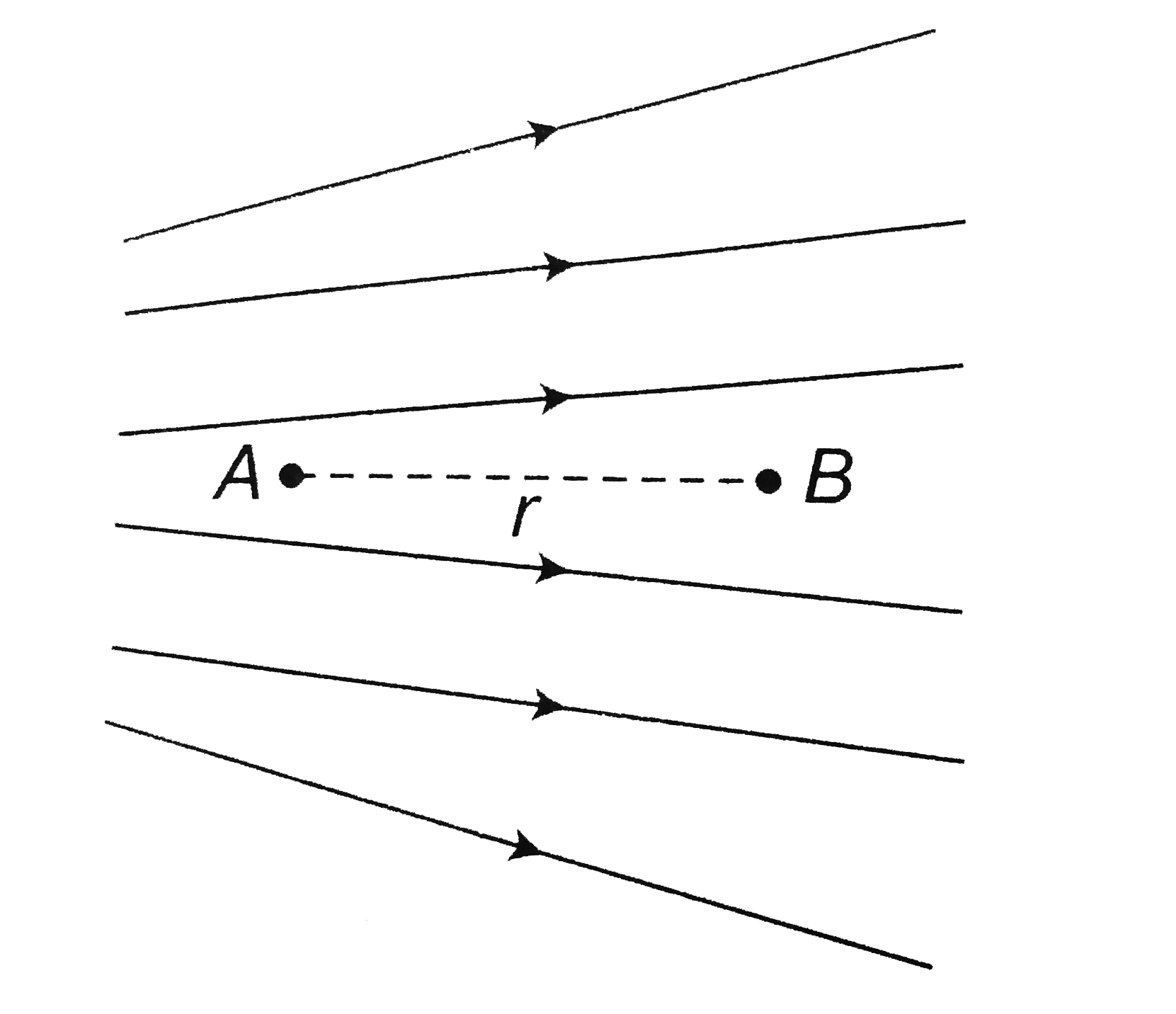 04:31View Solution
04:31View SolutionThe magnitude of electric field intensity E is such that, an electron placed in it would experience an electrical force equal to its weight is given by
01:13View SolutionA charge particle is free to move in an electric field. It will travel
03:14View SolutionTwo point charges `Q` and `-3Q` are placed at some distance apart. If the electric field at the location of `Q` is `E` then at the locality of `-3Q`, it is
02:13View SolutionCharges `q, 2q,3q` and `4q` are placed at the corners `A,B,C` and `D` of a square as shown in the following figure. The directon of electric field at the centre of the square is along
 02:21View Solution
02:21View SolutionThree infinitely long charge sheets are placed as shown in figure. The electric field at point `P` is
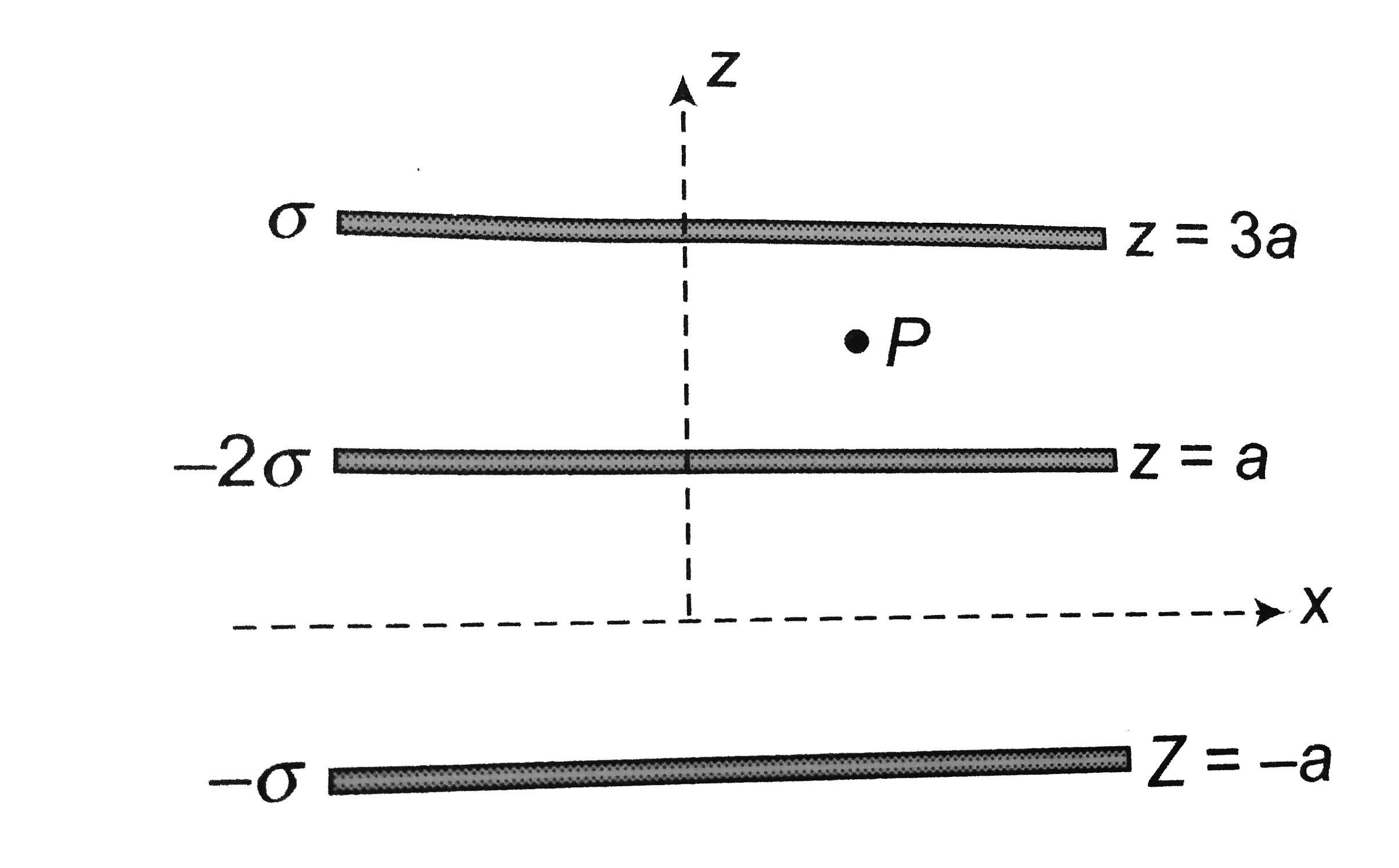 02:56View Solution
02:56View SolutionGauss's law is true only if force due to a charge varies as
01:35View SolutionThe electric intensity due to a uniformly charged infinite cylinder of radius `R` , at a distance `r(gt R)` , from its axis is proportional to
03:49View SolutionA sphere of radius `R` has a uniform distribution of electric charge in its volume. At a distance `x` from its centre, for `x lt R`, the electric field is directly proportional to
05:23View SolutionA charged ball B hangs from a silk thread S, which makes an angle `theta` with a large charged conducting sheet P, as shown in figure. The surface charge density `sigma` of the sheet is proportional to
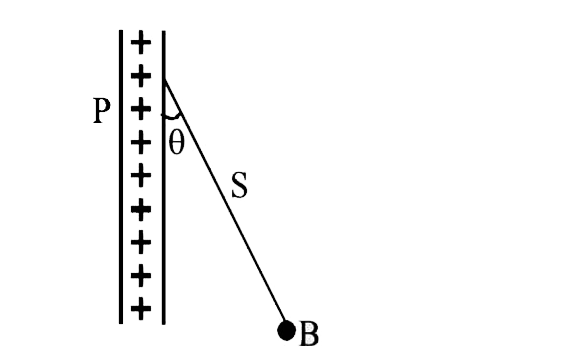 03:12View Solution
03:12View SolutionA charge q is placed at the centre of a cube of side `l` what is the electric flux passing through two opposite faces of the cube ?
02:13View SolutionA solid sphere `S_(1)` is connected to a charge reservoir through a heater H as shown in figure.
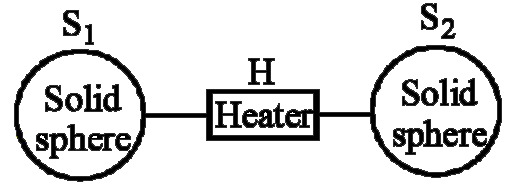
Flux through a closed spherical surface around `S_(1)` is given by `phi = alpha t^(2)` where `alpha` is a constant and t is time in seconds. If resistance of heater is R then select correct statements
(1) Power consumed by heater will be `4alpha^(2)e_(0)^(2) Rt^(2)`.
(2) Electric flux through a closed spherical surface around `S_(2)` will be `– alpha t_(2)`.
(3) Rate of change of electric flux through a closed spherical surface around `S_(2)` will be `–2alpha t`
(4) All of the above are correct03:27View SolutionA simple pendulum has a time period T. The bob is now given some positive charge –
(1) If some positive charge is placed at the point of suspension, T will increases
(2) If some positive charge is placed at the point of suspension, T will not change
(3) If a uniform downward electric field is switched on, T will increase
(4) If a uniform downward electric field is switched on, T will decrease02:13View SolutionA sphere of radius R contains charge density `rho(r )=A (R-r )`, for `0 lt r lt R`. The total electric charge inside the sphere is Q.
The value of A in terms of Q and R is03:00View SolutionA sphere of radius R contains charge density `rho(r )=A (R-r )`, for `0 lt r lt R`. The total electric charge inside the sphere is Q.
The electric field inside the sphere is04:31View SolutionA sphere of radius R contains charge density `rho(r )=A (R-r )`, for `0 lt r lt R`. The total electric charge inside the sphere is Q.
The electric outside the sphere is `(k=1/(4pi in_(0)))`05:27View SolutionAssetrion: Electric lines of force never cross each other.
Reason: Electric field at a point superimpose to give one resultant electric field03:28View SolutionAssertion: A point charge is brought in an electric field. The field at a nearby point will increase, whatever be the nature of the charge.
Reason: The electric field is independent of the nature of charge.02:33View SolutionStatement-1 : Direction of electric field at a point signifies direction of force experienced by a point charge placed at that point.
Statement-2 : Electric field is a vector quantity.01:33View Solution
physics questions and complete solutions for chapter ELECTROSTATICS of DISHA PHYSICS (HINGLISH) of Class 12
